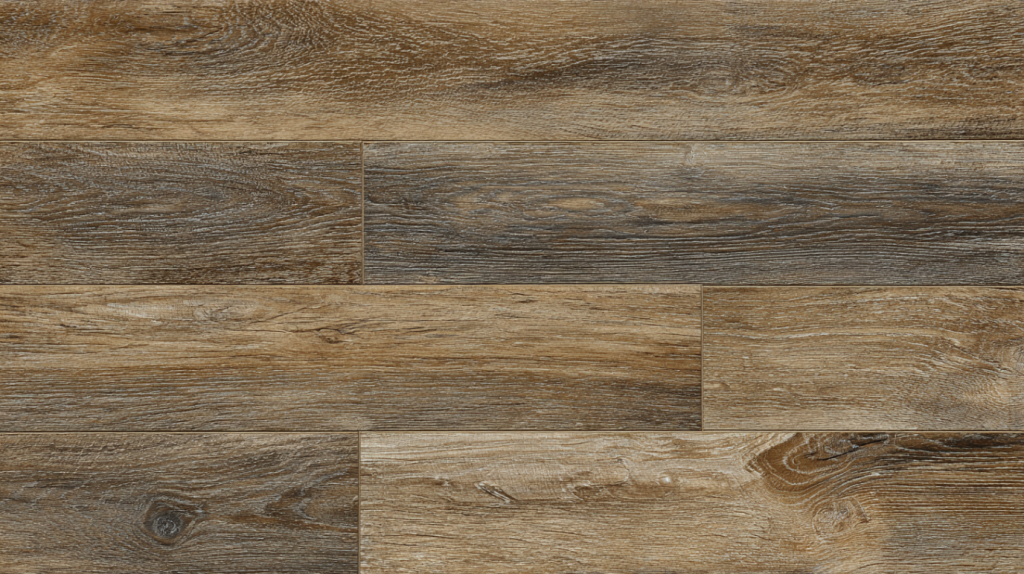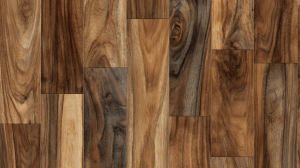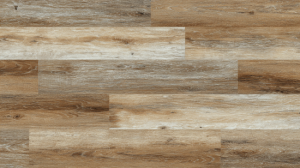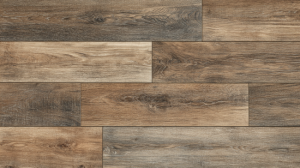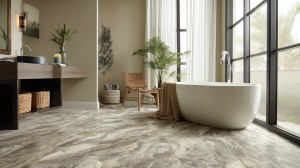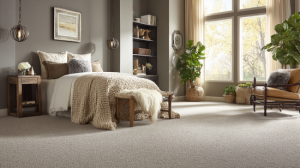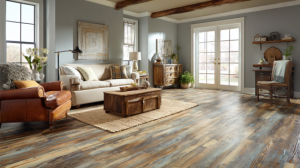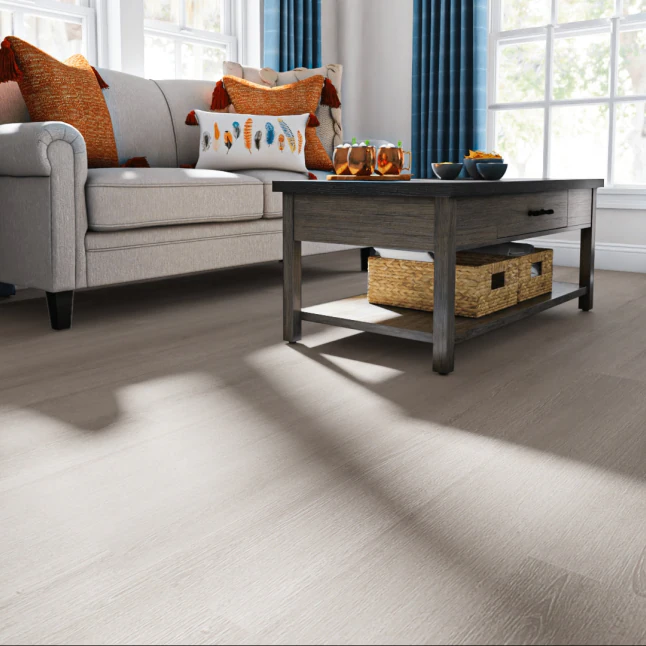
STAINMASTER Barnes Oak 12-mil x 7-3/32-in W x 47-in L Waterproof Luxury Vinyl Plank Flooring ( 17.33-sq ft Carton )
- STAINMASTER 100% waterproof Barnes Oak luxury vinyl plank is an American White Oak-look décor with warm, light grey hues that provides a contemporary look in any living space. Our vinyl plank offers long lasting, rigid core flooring ready for your active household. Our ACTIVELIFE SHIELD™ provides the dent, abrasion, and scratch resistance that busy homes demand. It’s waterproof, stain-resistant, and easy to clean so everyday accidents are not a worry with this floor! Install with ease using its click-lock system technology, and reduce installation costs with its pre-attached, acoustic underlayment. And, finally, have peace of mind knowing STAINMASTER vinyl plank floors are backed by a lifetime residential limited warranty and 15-Year light commercial limited warranty. Long-lasting, stylish, and durable, STAINMASTER Luxury Vinyl Plank Flooring is perfect for your home. Exclusively at Lowe’s.
- STAINMASTER 100% waterproof luxury vinyl plank flooring is wear-resistant and easy to install, perfect for kitchens, bathrooms, entryways and more
- This American White Oak-look decor features alternating grain patterns and on trend warm grey tones that bring a contemporary vibe to your space and ACTIVELIFE SHIELD™ provides scratch, dent, and abrasion resistance, and makes floors easy to clean
- Lowe’s Project Source floor mouldings for STAINMASTER Barnes Oak are Vinyl Multi-Transition, 5251617 – Qtr Rnd, 5251590 – Vinyl Stairnose, 5251643 – Waterproof Qtr Rnd, 3674489 – White Qtr Rnd, 1255399 – White Wallbase, 1255400
- Pre-attached 1mm acoustic padding underlayment offers sound absorption and reduces installation time and cost
- Antimicrobial product protection to resist odors and staining caused by certain bacteria
- Durable, stain-resistant, and easy to clean with a lifetime stain resistance limited warranty, exclusively at Lowe’s
- Click-lock system technology allows an easy and safe installation
- Lifetime Residential Limited Warranty; 15-Year Light Commercial Limited Warranty
- 7.46-in W x 47.8-in L x 6mm thick planks cover 17.33-sq ft; 12 mil wear layer; 35.6 lbs carton weight
$3.29
From Overwhelmed Homeowner to Confident Floor Chooser – Everything You Need to Know About This Premium Flooring Option
When I first started my flooring journey six months ago, I had no idea I’d become something of a flooring expert by the end of it. What began as a simple quest to replace my worn-out kitchen floor turned into an extensive research project that led me to Stainmaster Barnes Oak flooring – a decision that has completely transformed not just my home’s appearance, but my entire understanding of what quality flooring can offer.
Let me share everything I’ve learned about this remarkable flooring option, because if you’re reading this, chances are you’re in the same boat I was in – overwhelmed by choices, confused by technical specifications, and desperately seeking honest, real-world advice from someone who’s actually been through the process.
What Exactly is Stainmaster Barnes Oak Flooring?
When I first encountered Stainmaster Barnes Oak flooring, I’ll admit I was initially skeptical. The name “Stainmaster” immediately brought to mind carpet protection, and I wasn’t sure how that translated to hard surface flooring. But as I dove deeper into my research, I discovered that Stainmaster has leveraged decades of stain-resistance technology to create something truly impressive in the flooring world.
Stainmaster Barnes Oak is a luxury vinyl plank (LVP) flooring that combines advanced manufacturing techniques with sophisticated design to create an incredibly realistic wood-look floor. What sets it apart from other vinyl planks I examined is its multi-layer construction that includes a specialized wear layer infused with Stainmaster’s proprietary stain-resistance technology.
The “Barnes Oak” specifically refers to the particular wood pattern and color variation that mimics a premium oak hardwood. During my shopping process, I was amazed at how closely it resembled the real oak floors in my friend’s Victorian home – the same rich grain patterns, the subtle color variations, and even the authentic texture that you’d expect from genuine hardwood.
Laminate vs. Vinyl: Clearing Up the Confusion
One of the first hurdles I faced in my research was understanding whether Stainmaster Barnes Oak is laminate or vinyl plank flooring. This confusion is incredibly common, and I spent hours reading product descriptions that seemed to contradict each other.
Let me set the record straight: Stainmaster Barnes Oak is definitively a luxury vinyl plank (LVP) flooring, not laminate. The distinction matters more than you might think, and understanding the difference was crucial in my decision-making process.
Vinyl plank flooring like Stainmaster Barnes Oak is made from multiple layers of vinyl materials, typically including a waterproof core, a photographic layer that creates the wood appearance, and a protective wear layer on top. Laminate flooring, on the other hand, has a wood-based core (usually HDF or particleboard) with a photographic layer and protective coating.
During my research phase, I actually visited showrooms where I could feel both types side by side. The vinyl felt warmer underfoot and had a slight flexibility that laminate lacked. More importantly for my situation, the vinyl was completely waterproof while laminate could be damaged by moisture – a critical factor since I was planning to install it in my kitchen and potentially my bathroom.
Where to Find Stainmaster Barnes Oak Flooring
Finding where to purchase Stainmaster Barnes Oak flooring turned out to be easier than I initially expected, though it did require some strategic shopping to get the best deal. During my search, I discovered that this particular product line is available through several major retailers, each offering different advantages.
Home improvement giants like Home Depot and Lowe’s carry Stainmaster flooring products, and I found their showroom displays particularly helpful for seeing the actual product in different lighting conditions. However, I also discovered that specialty flooring retailers often had more knowledgeable staff who could answer my detailed questions about installation requirements and long-term performance.
What surprised me during my shopping journey was the price variation between retailers. The same product had price differences of up to twenty percent depending on where I looked. I ended up creating a spreadsheet to track pricing, availability, and any included services like delivery or installation consultations.
Online retailers also offer Stainmaster Barnes Oak, and while I couldn’t physically examine the product beforehand, some offered generous return policies and sample programs. I actually ordered samples from three different sources to compare not just the flooring itself, but also the packaging quality and shipping speed – factors that became important when I was ready to make my final purchase.
The Features That Won Me Over
The features of Stainmaster Barnes Oak flooring were what ultimately convinced me to choose this product over the dozen other options I’d been considering. Each feature addressed specific concerns I had based on my lifestyle and the challenges my previous flooring had faced.
The most impressive feature is the integrated stain resistance technology. Unlike topical treatments that can wear off over time, the stain resistance is built into the wear layer itself. During my research, I found customer reviews describing red wine spills, pet accidents, and even permanent marker incidents that cleaned up completely without leaving any trace.
The waterproof construction was another game-changer for me. My previous flooring had suffered water damage from a dishwasher leak, and I was determined not to face that expensive repair again. Stainmaster Barnes Oak’s waterproof core means that even standing water won’t penetrate and cause swelling or warping.
The thickness of the planks – typically around 6-7 millimeters – provides excellent stability and reduces the hollow sound that can plague thinner vinyl products. When I walked on the display samples, there was a solid, substantial feel that rivaled traditional hardwood.
The locking mechanism is another feature worth highlighting. The planks use an advanced click-lock system that creates tight joints without requiring glue. During my installation research, I learned that this not only makes installation faster but also allows for easier future repairs if individual planks ever need replacement.
Waterproof Performance: A Real-World Perspective
The question “Is Stainmaster Barnes Oak flooring waterproof?” was one of my primary concerns, given my previous water damage experience. I’m happy to report that this flooring is indeed completely waterproof, but let me explain what that really means in practical terms.
The waterproof designation applies to the plank itself – the core material won’t absorb water, swell, or delaminate even with prolonged exposure to moisture. However, proper installation is crucial to maintain this waterproof integrity. The seams between planks need to be properly locked, and transitions to other flooring materials require appropriate moisture barriers.
During my research, I spoke with several homeowners who had installed Stainmaster Barnes Oak in basements, bathrooms, and laundry rooms with excellent results. One particularly memorable conversation was with a customer who had experienced a significant plumbing leak that left standing water on their floor for several hours. While they needed to dry the subfloor thoroughly, the Stainmaster planks themselves were completely unaffected and went right back down without any warping or damage.
It’s worth noting that while the flooring itself is waterproof, the subfloor preparation still matters. Proper moisture barriers and level subfloors are essential for long-term performance, regardless of the flooring material’s water resistance.
Cost Analysis: Investment vs. Value
Understanding how much Stainmaster Barnes Oak flooring costs per square foot required more research than I initially anticipated. The pricing structure varies significantly based on several factors, and I learned that focusing solely on the per-square-foot cost can be misleading.
During my price research, I found Stainmaster Barnes Oak typically ranges from $3.50 to $5.50 per square foot for the material alone. However, the total project cost depends heavily on additional factors like underlayment requirements, transition strips, baseboards, and installation labor if you choose professional installation.
What I discovered during my cost analysis was that while Stainmaster Barnes Oak sits in the premium segment of vinyl plank pricing, it offers exceptional value when compared to genuine hardwood or high-end tile installations. The durability and warranty coverage mean that the cost per year of ownership is actually quite competitive with less expensive options that might need replacement sooner.
I also factored in the potential cost savings from the DIY-friendly installation process. Professional installation quotes I received ranged from $2 to $4 per square foot, so the ability to install it myself represented significant savings on my project.
Aesthetic Appeal: Color and Finish Options
The color and finish options for Stainmaster Barnes Oak flooring were more extensive than I expected when I first started looking. The Barnes Oak designation encompasses several color variations, each designed to capture different aspects of natural oak wood.
The standard Barnes Oak finish features warm brown tones with natural grain patterns and subtle color variation from plank to plank. What impressed me most was the attention to detail in the photographic layer – under close examination, I could see the individual grain lines, knots, and color variations that make real oak so appealing.
The finish itself has a subtle texture that enhances the realistic appearance while providing practical benefits. The textured surface helps hide minor scratches and provides better traction than completely smooth surfaces. During my showroom visits, I specifically tested this by walking on the samples in my socks – an important consideration since my family often goes barefoot at home.
The color consistency between batches was another factor I investigated. Through online forums and customer reviews, I learned that Stainmaster has excellent quality control, with minimal variation between production runs. This was important for my project since I knew I’d be purchasing the flooring in stages as my budget allowed.
Realism Factor: How Close to Real Oak?
The question of whether Stainmaster Barnes Oak mimics the look of real oak wood effectively was crucial to my decision-making process. As someone who genuinely loves the appearance of natural wood, I was concerned about ending up with flooring that looked obviously artificial.
After extensive comparison shopping and even visiting homes with both real oak and Stainmaster Barnes Oak, I can confidently say that the realism is remarkable. The photographic layer captures not just the color and grain patterns of oak, but also the subtle imperfections and variations that make natural wood so appealing.
The texture adds another layer of authenticity. Rather than the flat, obviously printed appearance of lower-quality vinyl planks, Stainmaster Barnes Oak has a dimensional surface that follows the grain pattern. When I ran my hand across the surface, it felt surprisingly similar to lightly sanded oak.
The edge treatment deserves special mention. The beveled edges create shadow lines between planks that enhance the individual plank appearance and add to the overall realistic effect. From a normal viewing distance, even flooring professionals I spoke with admitted they had to look closely to distinguish it from genuine oak.
However, I want to be honest about the limitations. Under very close inspection or in certain lighting conditions, the repetitive nature of the photographic pattern can become apparent. But for everyday living, the realism is impressive enough that visitors consistently assume it’s real wood until I tell them otherwise.
Scratch Resistance: Real-World Durability
As a pet owner and someone with an active household, the scratch resistance of Stainmaster Barnes Oak flooring was a major consideration. My previous flooring had suffered significant scratching from furniture moves, pet nails, and dropped objects, so I was determined to choose something more durable.
The wear layer on Stainmaster Barnes Oak includes aluminum oxide particles that provide excellent scratch resistance. During my research, I found numerous customer testimonials describing years of use with minimal visible wear, even in high-traffic areas.
I was particularly interested in real-world performance with pets. Through online forums and local customer references, I connected with several dog and cat owners who had installed this flooring. The consensus was overwhelmingly positive, with most reporting that normal pet activity – including the occasional nail scratch from excited dogs – left no visible marks.
Furniture protection remained important, however. While the flooring resists scratches better than many alternatives, heavy furniture dragged across the surface can still cause damage. I invested in furniture pads and make a point of lifting rather than dragging heavy items.
The scratch resistance also extends to everyday items like high heels, children’s toys, and kitchen utensils. During my first year with the flooring, I’ve been pleasantly surprised by how well it has maintained its appearance despite the inevitable mishaps of daily life.
Customer Reviews: The Voice of Experience
Reading customer reviews of Stainmaster Barnes Oak flooring became almost an obsession during my research phase. I spent hours on manufacturer websites, retailer platforms, and independent review sites trying to understand the real-world performance of this product.
The overall sentiment was remarkably positive, with most customers praising the appearance, durability, and ease of maintenance. Many reviews specifically mentioned the realistic wood appearance and how it had exceeded their expectations compared to other vinyl plank products they had considered.
Installation experiences varied widely in the reviews, largely depending on the customer’s DIY experience and the condition of their subfloor. Experienced DIYers consistently reported smooth installations, while first-time installers sometimes struggled with the initial learning curve but ultimately achieved professional-looking results.
The few negative reviews I found typically related to installation issues rather than product defects. Some customers had problems with uneven subfloors that created clicking sounds or slight gaps between planks. Others had purchased insufficient quantities and struggled to find matching batches for completion.
Long-term performance reviews were particularly valuable. Customers who had lived with the flooring for two to three years consistently reported maintained appearance and performance, with minimal wear even in high-traffic areas like entryways and kitchens.
High-Traffic Performance: Built to Last
The durability of Stainmaster Barnes Oak flooring in high-traffic areas was a critical factor in my decision, given that my main installation area includes the kitchen, dining room, and main hallway – essentially the busiest parts of my home.
The commercial-grade wear layer is designed to withstand significantly more foot traffic than typical residential flooring experiences. During my research, I discovered that similar Stainmaster products are used in retail and office environments, which gave me confidence in its residential durability.
The impact resistance was another important consideration. Unlike ceramic tile that can crack from dropped objects, or traditional hardwood that can dent, the vinyl construction of Stainmaster Barnes Oak has enough flexibility to absorb impacts without permanent damage.
Edge durability has proven excellent in my experience. The beveled edges maintain their sharp appearance even with regular foot traffic, and I haven’t experienced any chipping or cracking along the plank edges that can plague lower-quality products.
The stability of the planks in high-traffic areas has been impressive. Unlike floating floors that can develop movement or squeaking over time, the tight locking system and quality construction have maintained a solid, quiet surface even where we walk most frequently.
Kitchen and Bathroom Installation: Moisture Considerations
The question of whether Stainmaster Barnes Oak flooring can be installed in kitchens or bathrooms was particularly relevant to my project, since these were my primary target areas for replacement.
For kitchens, Stainmaster Barnes Oak is an excellent choice. The waterproof construction handles spills and cleaning without concern, while the stain resistance deals with the inevitable cooking mishaps. I’ve been particularly impressed with how well it handles the area around my sink and dishwasher, where my previous flooring had shown water damage.
Bathroom installation requires more careful consideration. While the flooring itself is completely waterproof, proper installation becomes critical in wet areas. The subfloor must be properly prepared with moisture barriers, and all transitions and edges need appropriate sealing to prevent water infiltration beneath the flooring.
I chose to install Stainmaster Barnes Oak in my powder room but opted for tile in my main bathroom shower area. The combination works beautifully, with the vinyl providing comfort and warmth in the main bathroom area while tile handles the direct water exposure in the shower.
Temperature stability is another advantage in these areas. Unlike some flooring materials that can expand and contract significantly with temperature and humidity changes, Stainmaster Barnes Oak remains dimensionally stable even with the typical fluctuations found in kitchens and bathrooms.
Installation Process: DIY Success Story
Understanding the installation process for Stainmaster Barnes Oak flooring was essential since I planned to tackle this as a DIY project. I’m reasonably handy but had never installed flooring before, so I needed to understand exactly what I was getting into.
The click-lock installation system is genuinely user-friendly. Each plank has precisely machined edges that lock together securely without requiring glue or nails. The learning curve exists mainly in understanding the proper angle and pressure needed to engage the locking mechanism, but once I installed the first few rows, the process became quite intuitive.
Subfloor preparation proved to be the most critical aspect of the installation. The surface needs to be clean, dry, and level within specific tolerances. I spent considerable time with a long straightedge checking for high and low spots, using floor leveling compound where necessary.
Cutting the planks required a few different tools depending on the type of cut. Straight cuts worked well with a utility knife and straightedge, while more complex cuts around obstacles required a jigsaw with a fine-tooth blade. The vinyl material cuts cleanly without splintering, making precise fits achievable even for a novice.
The most challenging aspect was maintaining straight lines and dealing with out-of-square rooms. Using chalk lines and constantly checking measurements prevented compounding errors that could have resulted in obvious problems at the room’s perimeter.
Professional Installation vs. DIY: Making the Choice
The decision of whether Stainmaster Barnes Oak flooring requires professional installation depends largely on your skill level, available time, and project complexity. Having completed my installation as a DIY project, I can offer perspective on both approaches.
Professional installation offers obvious advantages, particularly for complex layouts or challenging subfloor conditions. The installers I consulted during my planning phase had extensive experience with potential problems and solutions that I wouldn’t have anticipated as a first-time installer.
However, the DIY approach proved entirely feasible for my project. The manufacturer’s installation instructions were comprehensive, and numerous online resources provided additional guidance. The click-lock system is genuinely designed for homeowner installation, and the tools required are readily available and reasonably priced.
Cost savings from DIY installation were significant in my case – roughly $1,800 for professional installation versus about $200 in tool rental and materials for the DIY approach. However, this calculation doesn’t include the time investment, which was substantial for someone learning the process.
The warranty considerations were important to understand. DIY installation doesn’t void the product warranty, but installation-related problems aren’t covered regardless of who performs the work. This made careful attention to manufacturer specifications essential.
Cleaning and Maintenance: Surprisingly Simple
Learning how to clean and maintain Stainmaster Barnes Oak flooring was much simpler than I anticipated. Coming from hardwood floors that required specific cleaners and periodic refinishing, the low-maintenance nature of this vinyl plank flooring has been a pleasant surprise.
Daily maintenance consists simply of sweeping or vacuuming to remove dirt and debris. The stain-resistant surface means that most spills can be cleaned with plain water and a microfiber mop. For more stubborn spots, a mild, pH-neutral cleaner designed for vinyl flooring works effectively without damaging the surface.
The no-wax surface is a significant advantage. Unlike some flooring materials that require periodic sealing or waxing to maintain their appearance and protection, Stainmaster Barnes Oak retains its original appearance and performance with basic cleaning.
Deep cleaning occasionally involves a more thorough mopping with a vinyl floor cleaner, but this is needed far less frequently than I expected. The stain-resistant technology really does work – I’ve had red wine, coffee, and various food spills that cleaned up completely without leaving any trace.
One maintenance consideration is avoiding harsh chemicals or abrasive cleaners that could damage the wear layer. Bleach, ammonia-based cleaners, and scrubbing pads can potentially cause permanent damage, so sticking to manufacturer-recommended products is important.
Technical Specifications: Thickness and Construction
The thickness of Stainmaster Barnes Oak flooring planks contributes significantly to both its performance and installation characteristics. At approximately 6-7 millimeters thick, these planks provide excellent stability and durability while remaining easy to work with during installation.
The multi-layer construction includes a rigid core that prevents the flexing and movement that can plague thinner vinyl products. This thickness also contributes to the solid feel underfoot and reduces the hollow sound that can be noticeable with thinner materials.
From an installation perspective, the thickness provides more tolerance for minor subfloor imperfections while still requiring proper preparation for optimal performance. The substantial feel of the planks made the installation process more forgiving for a novice installer.
The thickness also affects transition planning. Moving from this flooring to adjacent areas required careful consideration of height differences and appropriate transition strips. In most cases, the thickness worked well with standard door jambs and room transitions, but some areas required minor adjustments.
Pet-Friendly Features: A Pet Owner’s Perspective
As a dog owner, determining whether Stainmaster Barnes Oak flooring is pet-friendly was crucial to my decision-making process. After more than a year of living with this flooring and two active dogs, I can provide genuine insight into its pet-related performance.
The scratch resistance has exceeded my expectations. Normal pet activity, including the occasional excitement-induced scrambling across the floor, has left no visible marks. The dogs’ nails, kept at reasonable length, don’t scratch the surface even when they’re running or playing indoors.
Accident cleanup has been remarkably simple. The waterproof construction means that pet accidents don’t penetrate the flooring, and the stain resistance ensures complete cleanup without lingering odors or stains. This has been particularly valuable during the house-training process with our younger dog.
The temperature characteristics make the flooring comfortable for pets. Unlike tile that can be cold in winter, Stainmaster Barnes Oak maintains a comfortable surface temperature year-round. The dogs seem to prefer lying on it compared to our previous flooring.
Traction is adequate for most pets, though very large dogs or those with mobility issues might benefit from area rugs in key locations. The subtle texture provides some grip, but it’s not as pronounced as some textured surfaces designed specifically for pet areas.
Warranty Coverage: Peace of Mind
Understanding the warranty that comes with Stainmaster Barnes Oak flooring provided important peace of mind for such a significant investment. The warranty structure is comprehensive but requires understanding the specific terms and conditions.
The residential warranty typically covers defects in materials and manufacturing for an extended period, often 20 years or more. This includes issues like delamination, excessive wear, or staining under normal use conditions. However, the warranty is prorated, meaning coverage decreases over time.
Installation-related problems are specifically excluded from the warranty, regardless of whether the installation was performed professionally or as a DIY project. This makes following manufacturer installation guidelines absolutely critical for maintaining warranty coverage.
Normal wear and tear, damage from improper maintenance, or problems resulting from environmental conditions beyond manufacturer specifications aren’t covered. Understanding these limitations helped me set appropriate expectations and maintenance practices.
The warranty claim process requires maintaining proof of purchase and following specific notification procedures. Keeping detailed records of purchase dates, batch numbers, and any maintenance performed helps ensure smooth warranty processing if needed.
Comparative Analysis: Stainmaster vs. Alternatives
Comparing how Stainmaster Barnes Oak flooring stacks up against other oak-style flooring options was essential for making an informed decision. I evaluated it against genuine hardwood, laminate alternatives, and other luxury vinyl products.
Against genuine oak hardwood, Stainmaster Barnes Oak offers significant advantages in moisture resistance, maintenance requirements, and initial cost. While it doesn’t match the long-term value potential of genuine hardwood that can be refinished multiple times, it provides excellent performance for most residential applications.
Compared to oak-style laminate flooring, the vinyl construction offers superior water resistance and a more realistic feel underfoot. The flexibility of vinyl versus the rigidity of laminate also makes it more forgiving during installation and more comfortable for extended standing.
When evaluated against other luxury vinyl plank products, Stainmaster Barnes Oak’s integrated stain resistance and brand reputation justify its premium pricing. The construction quality and realistic appearance compare favorably with other high-end options while offering unique stain-protection benefits.
The total cost of ownership calculation favored Stainmaster Barnes Oak when factoring in durability, maintenance requirements, and expected lifespan. While the initial investment is higher than basic alternatives, the long-term value proposition is compelling.
Environmental Considerations: Sustainability Profile
Investigating whether Stainmaster Barnes Oak flooring is eco-friendly or sustainably sourced revealed a complex picture that’s worth understanding for environmentally conscious consumers.
The vinyl construction means this flooring doesn’t directly contribute to deforestation, unlike genuine hardwood products. However, vinyl manufacturing does involve petroleum-based materials and chemical processes that have their own environmental implications.
Many luxury vinyl products, including those in the Stainmaster line, are manufactured with recycled content, reducing the overall environmental impact. The durability and long lifespan also contribute to sustainability by reducing replacement frequency compared to less durable alternatives.
The local air quality impact is minimal once the flooring is installed and any initial off-gassing has dissipated. Low-VOC certifications and lack of formaldehyde emissions make it suitable for indoor air quality-conscious households.
End-of-life disposal remains a challenge with vinyl products, as recycling options are limited compared to natural materials. However, the expected 20+ year lifespan means this becomes a distant consideration for most installations.
Final Thoughts: A Year Later
Reflecting on my Stainmaster Barnes Oak flooring experience after more than a year of daily living, I can confidently say it has exceeded my expectations in almost every category. The combination of realistic appearance, practical performance, and low maintenance requirements has made it an excellent choice for my lifestyle and home.
The decision-making process taught me the importance of thorough research and realistic expectation-setting. While this flooring isn’t perfect for every situation, it excels in the areas that matter most for busy households seeking the beauty of wood with modern performance benefits.
The installation experience, while challenging for a first-timer, was ultimately rewarding and saved significant money compared to professional installation. The manufacturer’s support resources and the forgiving nature of the click-lock system made success achievable even without prior flooring experience.
Most importantly, the daily living experience has been positive. The flooring looks as good today as when first installed, requires minimal maintenance, and continues to receive compliments from visitors who assume it’s genuine hardwood. For a busy household with pets and an active lifestyle, Stainmaster Barnes Oak flooring has proven to be an excellent investment that I would confidently recommend to others facing similar flooring decisions.
Whether you’re replacing worn flooring, building new, or simply wanting to upgrade your home’s appearance, Stainmaster Barnes Oak deserves serious consideration as a premium flooring solution that delivers both beauty and performance for years to come.

